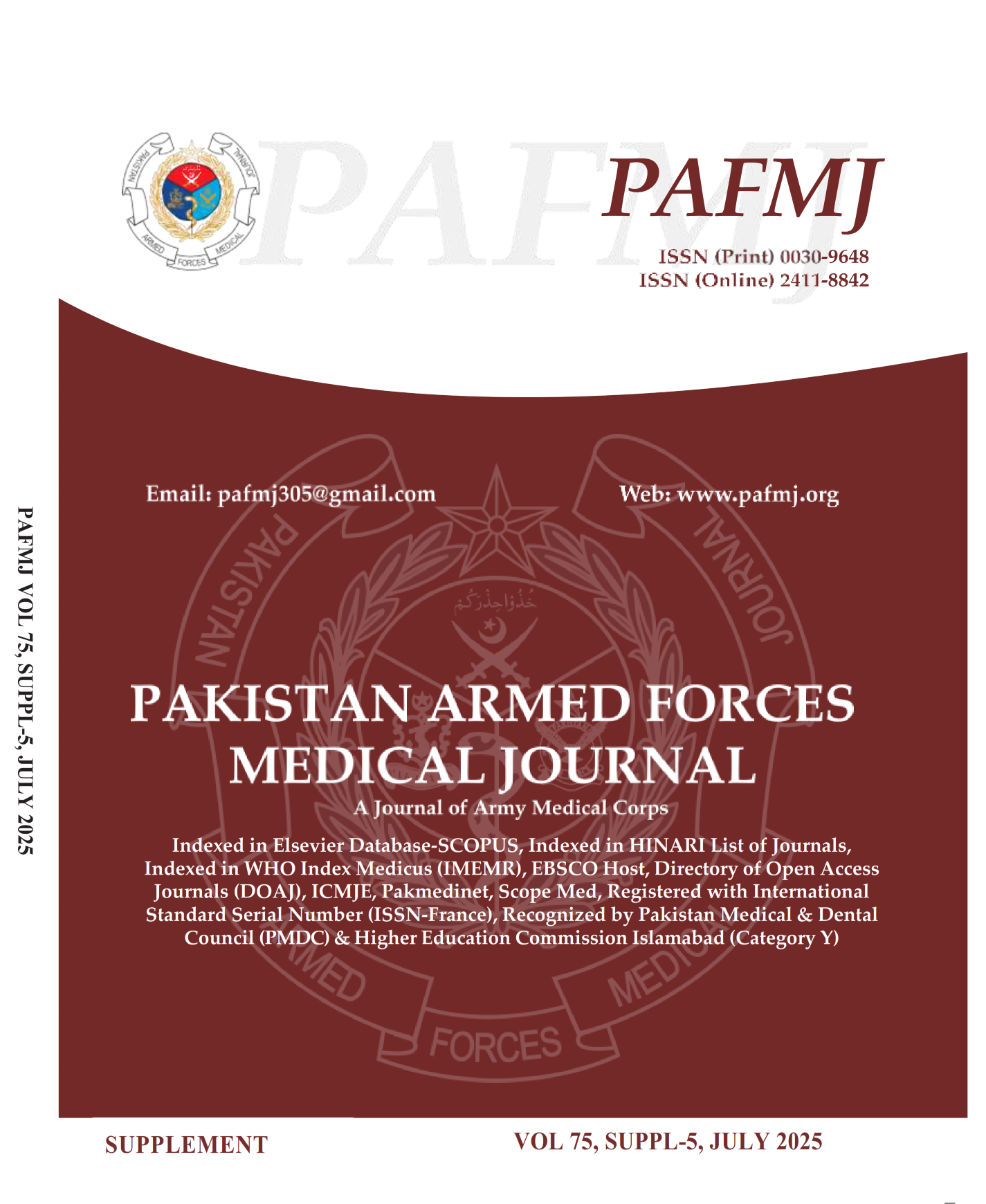Comparison of the Effects of Weight Bearing and Non-weight Bearing Exercise on Pain, Range of Motion and Disability in patients with Total Hip Replacement
DOI:
https://doi.org/10.51253/pafmj.v75iSUPPL-5.9507Keywords:
Pain, patients, range of motion, total hip replacement, weight bearingAbstract
Objective: To compare the effects of weight bearing and non-weight bearing exercise on pain, range of motion and disability in patients with total hip replacement.
Study Design: Randomized clinical trial
Place and Duration of Study: Outpatient department of Physical Therapy, Winner Health Care Hospital Gujranwala /6 months
Methodology: The study was conducted on 22 patients that undergo total hip replacement. All patients randomly allocated to weight bearing exercise group and non-weight bearing exercise group. Both groups received 12 treatment sessions for 6 weeks. Numeric Pain Rating Scale, Goniometer, hip disability and osteoarthritis outcome score were used to measure the treatment effect at baseline and after 6 weeks treatment of total 12 sessions in 6 weeks, with 2 sessions per week. The clinical trial number of this study is NCT05375565.
Results: This study showed that pretreatment p value of numeric pain rating scale was 0.401 and of post treatment session was 0.270 which showed that there was a significant decrease in pain level in both groups. Range of motion also improved after taking intervention in both groups. In both groups, total hip disability and osteoarthritis outcome score in weight bearing exercise group was 21.05% at pre level and was 56.42% at post level while in non-weight bearing exercise group total HOOS score was 22.68% at pre level and 39.78% at post level.
Conclusion: Weight-bearing exercise had proved to be more effective in treating disability as compared to non-weight bearing exercise in patients undergoing ..
Downloads
References
Vigdorchik JM, Sharma AK, Buckland AJ, Elbuluk AM, Eftekhary N, Mayman DJ, et al. 2021 Otto Aufranc Award: A simple Hip-Spine Classification for total hip arthroplasty: validation and a large multicentre series. The Bone & Joint Journal. 2021;103(7 Supple B):17-24.
https://doi.org/10.1302/0301-620X.103B7.BJJ-2020-2448.R2
2. Wijnen A, Bouma SE, Seeber GH, van der Woude LH, Bulstra SK, Lazovic D, et al. The therapeutic validity and effectiveness of physiotherapeutic exercise following total hip arthroplasty for osteoarthritis: a systematic review. PloS one. 2018;13(3):e0194517. https://doi.org/10.1371/journal.pone.0194517
3. Katz JN, Arant KR, Loeser RF. Diagnosis and treatment of hip and knee osteoarthritis: a review. Jama. 2021;325(6):568-78. doi:10.1001/jama.2020.22171
4. Winther SB, Foss OA, Husby OS, Wik TS, Klaksvik J, Husby VS. Muscular strength and function after total hip arthroplasty performed with three different surgical approaches: one-year follow-up study. HIP International. 2019;29(4):405-11.
https://doi.org/10.1177/1120700018810673
5. Karimanasseri C. How Can Gait Analysis Improve Total Hip Arthroplasty? Journal of Long-Term Effects of Medical Implants. DOI: 10.1615/JLongTermEffMedImplants.2022042591
6. Wang Y, Wluka AE, Simpson JA, Giles GG, Graves SE, De Steiger RN, et al. Body weight at early and middle adulthood, weight gain and persistent overweight from early adulthood are predictors of the risk of total knee and hip replacement for osteoarthritis. Rheumatology. 2013;52(6):1033-41.
https://doi.org/10.1093/rheumatology/kes419
7. FAYYAZ B, RIAZ S, KHAN RR, JAVED MA, SULMAN M, KHALID H. Effects of Motor Control Training of Hip Muscles on Pain and Physical Function After Total Hip Arthroplasty. Age (Years).51(8.89):50-4.47.
https://pjmhsonline.com/2021/feb/546.pdf
8. Myers CA, Laz PJ, Shelburne KB, Judd DL, Winters JD, Stevens-Lapsley JE, et al. Simulated hip abductor strengthening reduces peak joint contact forces in patients with total hip arthroplasty. Journal of biomechanics. 2019;93:18-27.
https://doi.org/10.1016/j.jbiomech.2019.06.003
9. Luthringer TA, Vigdorchik JM. A preoperative workup of a “hip-spine” total hip arthroplasty patient: a simplified approach to a complex problem. The Journal of Arthroplasty. 2019;34(7):S57-S70.
https://doi.org/10.1016/j.arth.2019.01.012
10. Leijendekkers RA, Marra MA, Kolk S, Van Bon G, Schreurs BW, Weerdesteyn V, et al. Gait symmetry and hip strength in women with developmental dysplasia following hip arthroplasty compared to healthy subjects: A cross-sectional study. PLoS One. 2018;13(2):e0193487.
https://doi.org/10.1371/journal.pone.0193487
11. Hermann A, Holsgaard-Larsen A, Zerahn B, Mejdahl S, Overgaard S. Preoperative progressive explosive-type resistance training is feasible and effective in patients with hip osteoarthritis scheduled for total hip arthroplasty–a randomized controlled trial. Osteoarthritis and cartilage. 2016;24(1):91-8.
https://doi.org/10.1016/j.joca.2015.07.030
12. Ninomiya K, Takahira N, Ikeda T, Suzuki K, Sato R, Mihara M. Effects of perioperative exercise therapy combined with nutritional supplementation on functional recovery after fast-track total hip arthroplasty. Journal of Orthopaedic Science. 2023;28(6):1291-7. https://doi.org/10.1016/j.jos.2022.09.012
13. Groot L, Latijnhouwers DA, Reijman M, Verdegaal SH, Vliet Vlieland TP, Gademan MG, Longitudinal Leiden Orthopaedics Outcomes of Osteoarthritis Study (LOAS) Group Nelissen RGHH van der Linden HMJ Kaptein BL Damen PJ Kaptijn HH Vehmeijer SBW Marijnissen WJCM Onstenk R.. Recovery and the use of postoperative physical therapy after total hip or knee replacement. BMC musculoskeletal disorders. 2022 Jul 13;23(1):666.
https://doi.org/10.1186/s12891-022-05429-z
14. Marchisio AE, Ribeiro TA, Umpierres CS, GalvÃo L, Rosito R, Macedo CA, Galia CR. Accelerated rehabilitation versus conventional rehabilitation in total hip arthroplasty (ARTHA): a randomized double blinded clinical trial. Revista do Colégio Brasileiro de Cirurgiões. 2020 Aug 12;47:e20202548.
https://doi: 10.1590/0100-6991e-20202548
15. Madara KC, Marmon A, Aljehani M, Hunter-Giordano A, Zeni Jr J, Raisis L. Progressive rehabilitation after total hip arthroplasty: a pilot and feasibility study. International journal of sports physical therapy. 2019 Jul;14(4):564. DOI: 10.26603/ijspt20190564
16. Abbas C, Daher J. Pilot study: post-operative rehabilitation pathway changes and implementation of functional closed kinetic chain exercise in total hip and total knee replacement patient. Journal of Bodywork and Movement Therapies. 2017 Oct 1;21(4):823-9.
https://doi.org/10.1016/j.jbmt.2017.01.009
17. Rossi MD, Hasson S, Kohia M, Pineda E, Bryan W. Relationship of closed and open chain measures of strength with perceived physical function and mobility following unilateral total knee replacement. Journal of Geriatric Physical Therapy. 2007 Apr 1;30(1):23-7. https://journals.lww.com/jgpt/abstract/2007/04000/relationship_of_closed_and_open_chain_measures_of.5.aspx
18. Matheis C, Stöggl T. Strength and mobilization training within the first week following total hip arthroplasty. Journal of bodywork and movement therapies. 2018 Apr 1;22(2):519-27.
Downloads
Published
Issue
Section
License
Copyright (c) 2025 Habiba Tauqeer, Hina Gul, Rida Mustafa, Syda Nimra Javed

This work is licensed under a Creative Commons Attribution-NonCommercial 4.0 International License.















